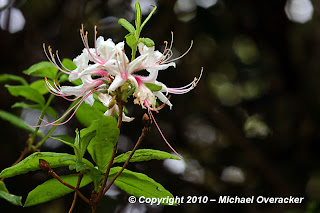These images are from the second week in May 2010. Some of these images are from the wildflower garden at the Roanoke Valley Garden Club offices on Colonial Avenue, one is from my yard, and the rest are along the Blue Ridge Parkway on the high plateau in Floyd County. I was distressed while shooting the images on the Parkway because the large amount of Flame Azalea and Pinxter Flower bushes along the Parkway were destroyed by the severe winter snow and ice that we had during the winter of 2009/2010. In one area that I would visit often, almost 95% of the bushes were gone. Where once stood about twenty Pinxter Flower bushes, only one remained. It was devastating. I know it is the way of nature, but the damage was disheartening none the less.
This is Blue Salvia (Salvia divinorum).
This is Red Columbine (Aquilegia canadensis).
This is Wild Blue Flax (Linum lewisii). Stunning colored blooms.
This is the Bachelor Button (Centaurea cyanus), also known as a Cornflower.
This is Virginia Spiderwort (Tradescantia virginiana). This image was shot while it was raining.
This wildflower is Star Chickweed (Stellaria corei)
This wildflower is a Wild Geranium (Geranium maculatum). This single bloom was one of hundreds in the area.
The Flame Azalea (Rhododendron calendulaceum). Most of the Flame Azalea where this photo was taken were killed off by a brutal winter storm.
The Flame Azalea (Rhododendron calendulaceum), the Floyd County version.
These are Pinxter Flowers (Rhododendron periclymenoides). Their numbers were decimated in this area by a brutal winter.
This wildflower is Bowman's Root (Porteranthus trifoliatis)
This wildflower is Mountain Laurel (Kalmia latifolia).
Above is a Pinxter Flower (Rhododendron periclymenoides). Very odd, yet stunning in their frailty.





















































